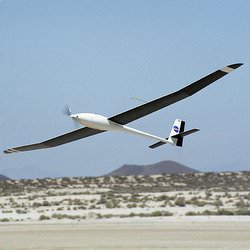

Unmanned prototype sailplane. Image credit: NASA. Click to enlarge.
With the graceful flight of hawks and eagles in mind, NASA aerospace engineer Michael Allen recently hand-launched a 15-pound motorized model sailplane over the Southern California desert. He was hoping it would catch plumes of rising air called thermals.
The sailplane did just that several times without human intervention during a series of research flights at NASA’s Dryden Flight Research Center, Calif. The tests validated Allen’s premise that using thermal lift could significantly extend the range and flight endurance of small unmanned air vehicles. Thermal lift increases vehicle endurance and saves fuel. This is significant, as small vehicle flight duration is often restricted by limited fuel capacity.
Allen and his team of engineers and technicians flew the remote-controlled RnR Products sailplane 17 times from July through mid-September. The sailplane was modified by Dryden aerospace technicians to incorporate a small electric motor and an autopilot programmed to detect thermals.
The 14-foot-wingspan model flew to an altitude of about 1,000 feet. The ground-based remote control pilot then handed off control to the sailplane’s onboard autopilot. The autopilot software flew the plane on a pre-determined course over the northern portion of Rogers Dry Lake at Edwards Air Force Base, Calif., until it detected an updraft. As the aircraft rose with the updraft, the engine automatically shut off. The aircraft circled to stay within the lift from the updraft.
Allen said the small sailplane added 60 minutes to its endurance by autonomous thermal soaring. The modified sailplane gained an average altitude in 23 updrafts of 565 feet, and in one strong thermal ascended 2,770 feet.
“The flights demonstrated a small unmanned vehicle can mimic birds and exploit the free energy that exists in the atmosphere,” Allen said. “We have been able to gather useful and unique data on updrafts and the response of the aircraft in updrafts. This will further the technology and refine the algorithms used.”
Small, portable, unpiloted, long-endurance vehicles could fulfill a number of observation roles including forest fire monitoring, traffic control, search and rescue.
For more information about flight research at Dryden on the Web visit:
http://www.nasa.gov/centers/dryden
For information about NASA and agency programs on the Web, visit:
http://www.nasa.gov/home
Original Source: NASA News Release
Computers are an integral part of space exploration, keeping them functioning when away from Earth.…
By the end of this decade, NASA, the Chinese National Space Agency (CNSA), Roscosmos, and…
Could a new, fifth force of nature provide some answers to our biggest questions about…
In 2015, the United Nations adopted the 2030 Agenda for Sustainable Development—the Sustainable Development Goals…
Astronomers have been battling threats to their clear skies on all fronts lately. One of…
If you were Captain of the first USS Enterprise, where would you go!? Humanity is…